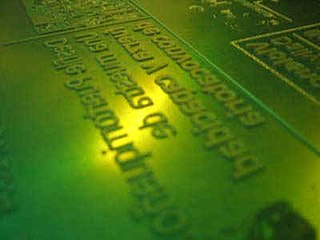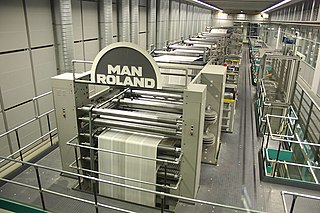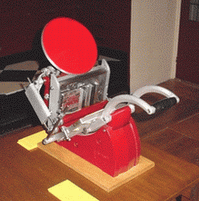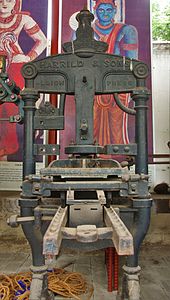
Lithography is a planographic method of printing originally based on the immiscibility of oil and water. The printing is from a stone or a metal plate with a smooth surface. It was invented in 1796 by the German author and actor Alois Senefelder and was initially used mostly for musical scores and maps. Lithography can be used to print text or images onto paper or other suitable material. A lithograph is something printed by lithography, but this term is only used for fine art prints and some other, mostly older, types of printed matter, not for those made by modern commercial lithography.

Printing is a process for mass reproducing text and images using a master form or template. The earliest non-paper products involving printing include cylinder seals and objects such as the Cyrus Cylinder and the Cylinders of Nabonidus. The earliest known form of printing as applied to paper was woodblock printing, which appeared in China before 220 AD for cloth printing. However, it would not be applied to paper until the seventh century. Later developments in printing technology include the movable type invented by Bi Sheng around 1040 AD and the printing press invented by Johannes Gutenberg in the 15th century. The technology of printing played a key role in the development of the Renaissance and the Scientific Revolution and laid the material basis for the modern knowledge-based economy and the spread of learning to the masses.

Flexography is a form of printing process which utilizes a flexible relief plate. It is essentially a modern version of letterpress, evolved with high speed rotary functionality, which can be used for printing on almost any type of substrate, including plastic, metallic films, cellophane, and paper. It is widely used for printing on the non-porous substrates required for various types of food packaging.

Offset printing is a common printing technique in which the inked image is transferred from a plate to a rubber blanket and then to the printing surface. When used in combination with the lithographic process, which is based on the repulsion of oil and water, the offset technique employs a flat (planographic) image carrier. Ink rollers transfer ink to the image areas of the image carrier, while a water roller applies a water-based film to the non-image areas.

Letterpress printing is a technique of relief printing. Using a printing press, the process allows many copies to be produced by repeated direct impression of an inked, raised surface against sheets or a continuous roll of paper. A worker composes and locks movable type into the "bed" or "chase" of a press, inks it, and presses paper against it to transfer the ink from the type, which creates an impression on the paper.

A brayer is a hand-tool used historically in printing and printmaking to break up and "rub out" (spread) ink, before it was "beaten" using inking balls or composition rollers. The word is derived from the verb to "bray", meaning "to break, pound, or grind small, as in a mortar". A brayer consists of a short wooden cylinder with a handle fitted to one end; the other, flat end is used to rub the ink. In the late nineteenth century the term was applied in the United States to a small hand-roller, "used for spreading ink on the inking table, and for applying it to the distributing plates or rollers connected with presses". Such small rollers were sold as "brayers" from at least 1912 and later in the century the term was applied in the U.S. to hand-rollers of all sorts and sizes. It retains its original meaning in Europe.

Rotogravure is a type of intaglio printing process, which involves engraving the image onto an image carrier. In gravure printing, the image is engraved onto a cylinder because, like offset printing and flexography, it uses a rotary printing press.
A platen is a flat platform with a variety of roles in printing or manufacturing. It can be a flat metal plate pressed against a medium to cause an impression in letterpress printing. Platen may also refer to a typewriter roller which friction-feeds paper into position below the typebars or print head. It can refer to the glass surface of a copier, and the rotating disk used to polish semiconductor wafers.

Collotype is a gelatin-based photographic printing process invented by Alphonse Poitevin in 1855 to print images in a wide variety of tones without the need for halftone screens. The majority of collotypes were produced between the 1870s and 1920s. It was the first form of photolithography.

The printer's key, also known as the number line, is a line of text printed on the copyright page of books, used to indicate the print run. Publishers began this convention about the middle of the 20th century; its use became common after 1970.

Solid ink is a type of ink used in printing. Solid ink is a waxy resin-based polymer that must be melted prior to usage, unlike conventional liquid inks. The technology is used most in graphics and large format printing environments, where color vividness and cost efficiency are important.

Bryan Donkin FRS FRAS (22 March 1768 – 27 February 1855) developed the first paper making machine and created the world's first commercial canning factory. These were the basis for large industries that continue to flourish today. Bryan Donkin was involved with Thomas Telford's Caledonian Canal, Marc and Isambard Brunel's Thames Tunnel, and Charles Babbage's computer. He was an advisor to the government and held in high esteem by his peers.

A jobbing press, job press, or jobber is a variety of printing press used in letterpress printing.

The Albion press is a model of early iron hand printing press, originally designed and manufactured in London by Richard Whittaker Cope around 1820.

Adana Printing Machines were manufactured from 1922 to 1999 in Twickenham, England. Although most of the printing presses produced by Adana were aimed at hobby printers, they were frequently put to commercial use. Adanas are still to be found throughout the world in the hands of colleges, enthusiasts and professional printers. Caslon Limited manufactured machines after a takeover of the company in 1987.

An ink ball, inking ball, or dabber was a tool used in printmaking and letterpress printing to apply ink to the plate or type to be printed.
Robert Harrild was an English printing pioneer. Harrild was the founder of the business Harrild & Sons, his history is recorded in 'The House of Harrild' by Edward Liveing written in 1949, which gives the complete history of the Company, and also many names and dates of Harrilds.

A composition roller is a tool used in letterpress printing to apply ink to a bed of type in a printing press. It consists of a cylinder made of a substance known as "roller composition" or simply "composition", a mixture of glue and sugar, with various additives such as glycerin depending on the particular recipe. Early recipes also included gypsum plaster and tar, though these were eventually found unnecessary.
Edward Shickle Cowper (1790–1852) was an English printing engineer, inventor, and academic.
Peter Hooker Limited owned an engineering business originally established in 1827 and carried on under the name Messrs Peter Hooker as printers' engineers at 12 Pump Row, Old Street Road, St Luke's, later at Pear Tree Court, Farringdon Road, London EC. The limited liability company was formed to own it in 1900. Operations were moved to Black Horse Lane Walthamstow, Essex, in 1901.





















